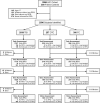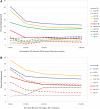Symptom Frequency and Persistence in the First Year after Traumatic Brain Injury: A TRACK-TBI Study
- PMID: 35078327
- PMCID: PMC8892966
- DOI: 10.1089/neu.2021.0348
Symptom Frequency and Persistence in the First Year after Traumatic Brain Injury: A TRACK-TBI Study
Abstract
Symptom endorsement after traumatic brain injury (TBI) is common acutely post-injury and is associated with other adverse outcomes. Prevalence of persistent symptoms has been debated, especially in mild TBI (mTBI). A cohort of participants ≥17 years with TBI (n = 2039), 257 orthopedic trauma controls (OTCs), and 300 friend controls (FCs) were enrolled in the TRACK-TBI study and evaluated at 2 weeks and 3, 6, and 12 months post-injury using the Rivermead Post-Concussion Symptoms Questionnaire (RPQ). TBI participants had significantly higher symptom burden than OTCs or FCs at all times, with average scores more than double. TBI cases showed significant decreases in RPQ score between each evaluation (p < 0.001), decreasing ∼1.7 points per month between 2 weeks and 3 months and 0.2 points per month after that. More than 50% of the TBI sample, including >50% of each of the mild and moderate/severe TBI subsamples, continued to endorse three or more symptoms as worse than pre-injury through 12 months post-injury. A majority of TBI participants who endorsed a symptom at 3 months or later did so at the next evaluation as well. Contrary to reviews that report symptom resolution by 3 months post-injury among those with mTBI, this study of participants treated at level 1 trauma centers and having a computed tomography ordered found that persistent symptoms are common to at least a year after TBI. Additionally, although symptom endorsement was not specific to TBI given that they were also reported by OTC and FC participants, TBI participants endorsed over twice the symptom burden compared with the other groups.
Keywords: TRACK-TBI; post-concussion symptoms; post-traumatic symptoms; traumatic brain injuries.
Conflict of interest statement
No competing financial interests exist.
Figures






Comment in
-
Response to Machamer et al., "Symptom Frequency and Persistence in the First Year after Traumatic Brain Injury: A TRACK-TBI Study" (doi: 10.1089/neu.2021.0348).J Neurotrauma. 2023 Mar;40(5-6):595-596. doi: 10.1089/neu.2022.0292. Epub 2022 Dec 26. J Neurotrauma. 2023. PMID: 36352817 No abstract available.
Similar articles
-
Association of Sex and Age With Mild Traumatic Brain Injury-Related Symptoms: A TRACK-TBI Study.JAMA Netw Open. 2021 Apr 1;4(4):e213046. doi: 10.1001/jamanetworkopen.2021.3046. JAMA Netw Open. 2021. PMID: 33822070 Free PMC article.
-
Functional Recovery, Symptoms, and Quality of Life 1 to 5 Years After Traumatic Brain Injury.JAMA Netw Open. 2023 Mar 1;6(3):e233660. doi: 10.1001/jamanetworkopen.2023.3660. JAMA Netw Open. 2023. PMID: 36939699 Free PMC article.
-
Sex differences in outcomes from mild traumatic brain injury eight years post-injury.PLoS One. 2022 May 27;17(5):e0269101. doi: 10.1371/journal.pone.0269101. eCollection 2022. PLoS One. 2022. PMID: 35622845 Free PMC article.
-
[Mild traumatic brain injury and postconcussive syndrome: a re-emergent questioning].Encephale. 2012 Sep;38(4):329-35. doi: 10.1016/j.encep.2011.07.003. Epub 2011 Aug 31. Encephale. 2012. PMID: 22980474 Review. French.
-
Behavioral Therapies and Mind-Body Interventions for Posttraumatic Headache and Post-Concussive Symptoms: A Systematic Review.Headache. 2019 Feb;59(2):151-163. doi: 10.1111/head.13455. Epub 2018 Dec 1. Headache. 2019. PMID: 30506568
Cited by
-
The SUCCESS Peer Mentoring Program for College Students with Concussion: Preliminary Results of a Mobile Technology Delivered Intervention.Int J Environ Res Public Health. 2023 Apr 7;20(8):5438. doi: 10.3390/ijerph20085438. Int J Environ Res Public Health. 2023. PMID: 37107720 Free PMC article.
-
Brain activity dynamics after traumatic brain injury indicate increased state transition energy and preference of lower order states.Neuroimage Clin. 2025;46:103799. doi: 10.1016/j.nicl.2025.103799. Epub 2025 May 10. Neuroimage Clin. 2025. PMID: 40381376 Free PMC article.
-
Distinct symptom recoveries based upon highest level of care in patients with sport-related concussion or traumatic brain injury and Glasgow Coma Scale 13-15.Clin Neurol Neurosurg. 2025 Sep;256:109017. doi: 10.1016/j.clineuro.2025.109017. Epub 2025 Jun 16. Clin Neurol Neurosurg. 2025. PMID: 40532286
-
Contrasting Characteristics and Outcomes of Sports-Related and Non-Sports-Related Traumatic Brain Injury.JAMA Netw Open. 2024 Jan 2;7(1):e2353318. doi: 10.1001/jamanetworkopen.2023.53318. JAMA Netw Open. 2024. PMID: 38265796 Free PMC article.
-
Effects of age and time since injury on traumatic brain injury blood biomarkers: a TRACK-TBI study.Brain Commun. 2022 Dec 1;5(1):fcac316. doi: 10.1093/braincomms/fcac316. eCollection 2023. Brain Commun. 2022. PMID: 36642999 Free PMC article.
References
-
- Dikmen, S., Machamer, J., Fann, J.R., and Temkin, N. (2010). Rates of symptom reporting following traumatic brain injury. J. Int. Neuropsychol. Soc. 16, 401–411. - PubMed
-
- Ponsford, J.L., Downing, M.G., Olver, J., Ponsford, M., Acher, R., Carty, M., and Spitz, G. (2014). Longitudinal follow-up of patients with traumatic brain injury: outcome at two, five, and ten years post-injury. J. Neurotrauma 31, 64–77. - PubMed
-
- Olver, J.H., Ponsford, J.L., and Curran, C.A. (1996). Outcome following traumatic brain injury: a comparison between 2 and 5 years after injury. Brain Inj. 10, 841–848. - PubMed
-
- Ruet, A., Bayen, E., Jourdan, C., Ghout, I., Meaude, L., Lalanne, A., Pradat-Diehl, P., Nelson, G., Charanton, J., Aegerter, P., Vallat-Azouvi, C., and Azouvi, P. (2019). A detailed overview of long-term outcomes in severe traumatic brain injury eight years post-injury. Front. Neurol. 10, 120. - PMC - PubMed

